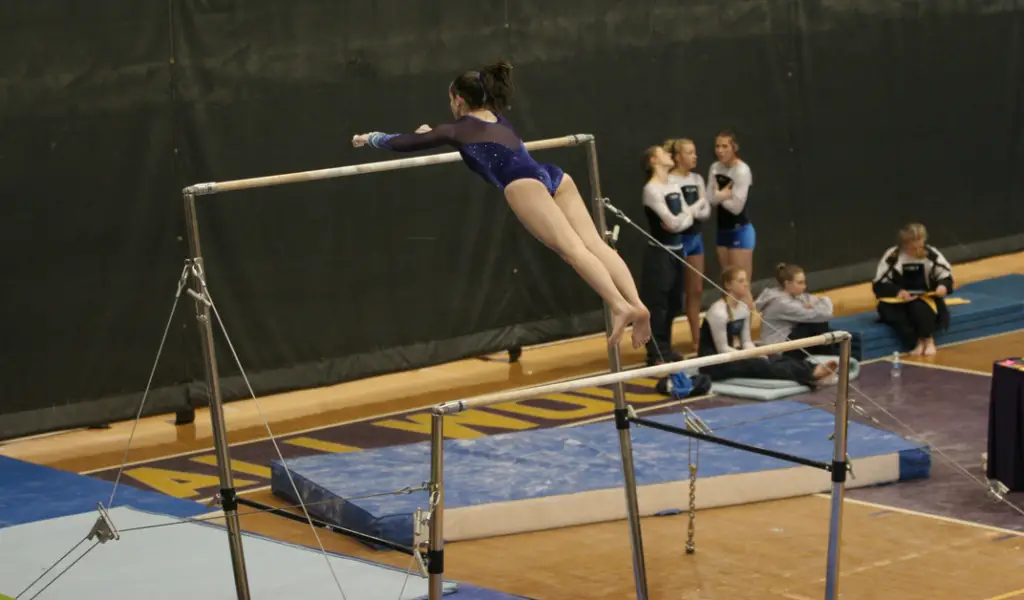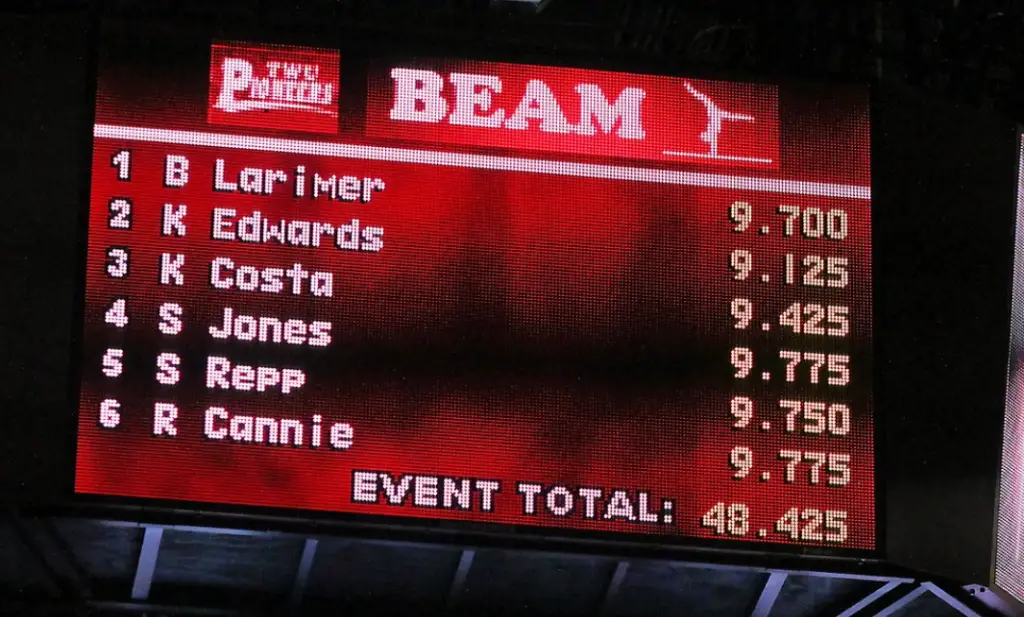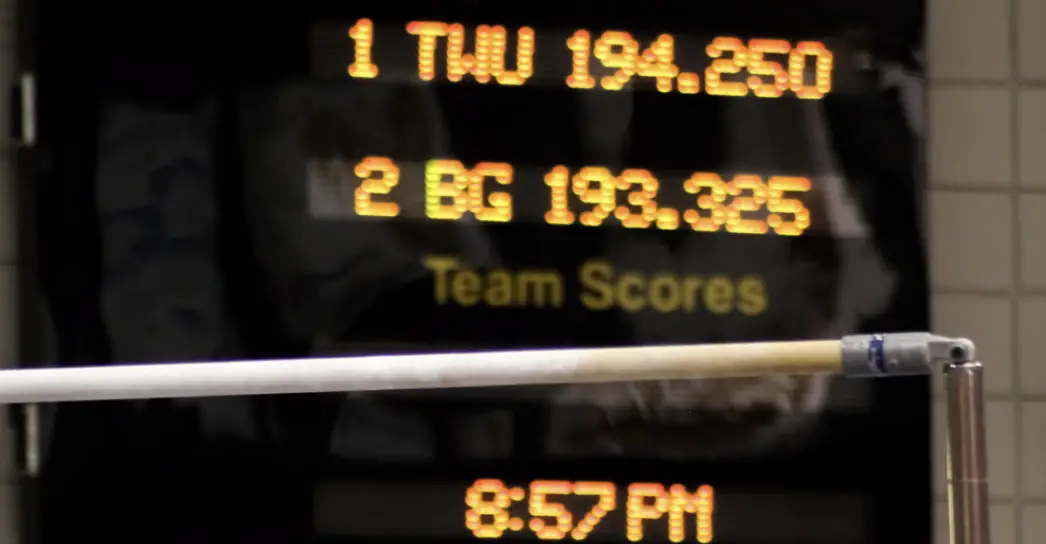The scores for team gymnastics can sometimes be confusing to keep up with, even when you already know how the team scores are calculated. However, this can be a vital part of gymnastics meets and team rankings so if you or your child are learning this sport you should definitely learn how it is done.
The team score depends on the size of the team and for small teams it is made up of the top three scores that the gymnasts on that team made for that event. For large teams this score is made up of the top five scores that the gymnasts on the team made for that event.
This means that no matter how many gymnasts on a team compete, only those top scores will count. A small team has only 3-6 gymnasts in it, while a large team has 7 gymnasts or more in it. Doing it this way helps to make sure that larger teams get no material advantage over smaller teams, since it is the same no matter the size of the team.
At team gymnastics competitions, whether it is for grade school kids or college students, each individual gymnast’s scores must first be calculated. For college teams this is done by using the same method that level 10 of gymnastics is usually scored with. If you don’t know what I mean by that, then let me take a moment to explain how that kind of scoring works.
While a perfect score is 10.00 for each of the events, you only start off with a 9.50 point SV –Starting Value – for each of the events, except for the vault event which I will get to in a moment. This is if you include all of the required skills and maneuvers in each of your routines.

The remaining 0.50 points are called bonus points and they must be earned by using two methods. One of these methods is called the difficulty bonus points, and the way that you get these is to include extra D and E skills into your routine.
Each of these skills is worth a certain amount of points when put in your routine. However, no matter how many of these skills you include you can only get a maximum of 0.40 points from your difficulty bonus which will not take you all the way to your 10.00 point score.
This is where the other method for earning points comes into play. These are called the connection bonus points and the way that you get these is to connect various maneuvers in the form combination maneuvers. Each type of connection is worth a certain amount of points, but once again you can only get a maximum of 0.40 points here.
You may have noticed that the 0.40 you can get for each of the kinds of bonus points can potentially make your score add up more than 10.00 points if you get the full amount of both, however a 10.00 point score is still the highest that you can get. Since you will doubtless make at least one mistake in your routine, this extra padding of bonus points can help to cover any mistakes that you might make.
The vaulting on the other hand is a bit different. Each vault is worth a certain number of points, some being less than 10.00 points while others are more than 10.00 points. The most you can get, however, is still 10.00 points with any errors that you make being deducted from either the amount of points that your vault is worth or from 10.00 points if your vault is worth more than that amount.

Once all of the gymnasts from each team have done their routines for a certain event, then the three highest scores are picked from the results of each team’s gymnasts. These three scores are then added together to form the team’s score for that event. Then the next event will start and all the gymnasts from each team will do their routines.
At the end of all of these, the three highest scores for each team will once again be taken and added up. These may be scores from the same gymnasts whose scores were counted in the last event, or they may be scores from different gymnasts whose scores were not counted before.
This whole process will be done for all of the events, and at the end of the competition the team scores will be added together to form the teams AA –All Around – score just like it is usually done for individual gymnasts. The winning team will be the one with the highest AA score which can be as high as 120.00 points for the four events if the top three scores are being counted.
Team scores play a very large part in team rankings and team rankings in turn pay a vital role in whether your team makes it to state, national, or world competitions. The Olympic team scoring does things a bit differently. Even though there are five gymnasts on the Olympics gymnastics team, only three of these five may compete at each event.
For this the scores of all three of these gymnasts are counted whether they are good or bad. Each of the five gymnasts can compete in either all of the events or they may only compete in one of the events. It is for this reason that a gymnast who is an event specialist and is really good at one or two particular events may sometimes be picked for the Olympic team even if they do not have the highest AA score.
A Brief Explanation Of Team Rankings
Before the season actually begins, the first of the team rankings will come out. This will be based on a variety of factors such as where the team was ranked at by the end of the previous season, if any of the team members left since then, if there are any noteworthy new team members, and a variety of other factors.
After the season begins, these rankings get updated every week. The scores for the first six competitions are the first things to affect the ranking, these six scores being averaged out after each competition that the team participates in. In the ranking lineup each team is placed above the teams that their average is higher than and below the teams that their average is lower than.
After more than six meets have been done then the scoring system changes. From then on the top three scores from the away competitions are noted along with the other three highest scores which can either be home scores or away scores. The highest one of these six scores is dropped and the remaining five scores are then averaged out to determine the team’s ranking.
While this likely sounds like it is quite complicated, doing it this way serves two purposes. One is that it allows a team to get rid of their low scores if they had a particularly bad meet. The other is that if a team did ridiculously good at only one meet it prevents them from getting ahead of any teams that are getting higher AA scores than them on a more regular basis.
Once the season ends the top 36 teams are divided up between six different locations to compete in the regional competitions. Out of the 6 teams at each location, only 2 of these teams go from the regional competitions to the national competitions for a total of 12 teams that go to the nationals.
These 12 teams will not go directly against each other at this point still, but are now divided into four groups of three teams. Two of these groups will compete against each other while the other two groups will compete against each other as well. The winning three teams from each of these competitions are the final six teams that will now compete against each other individually, with the winning team taking the title of National Champion team.

